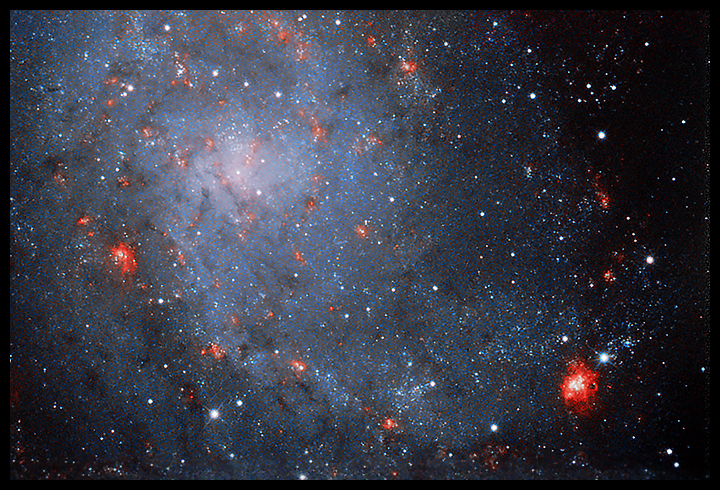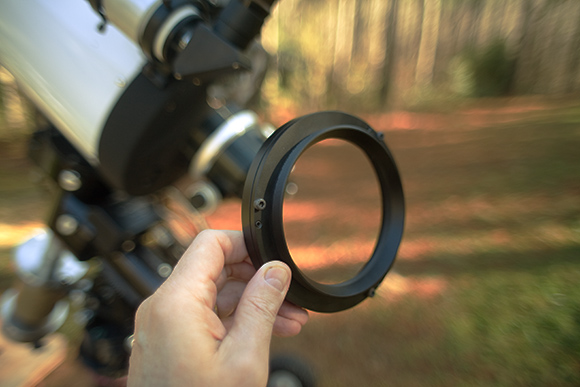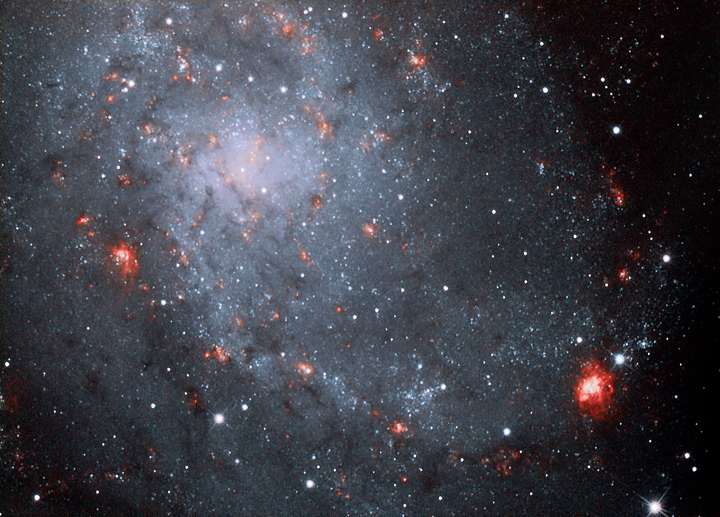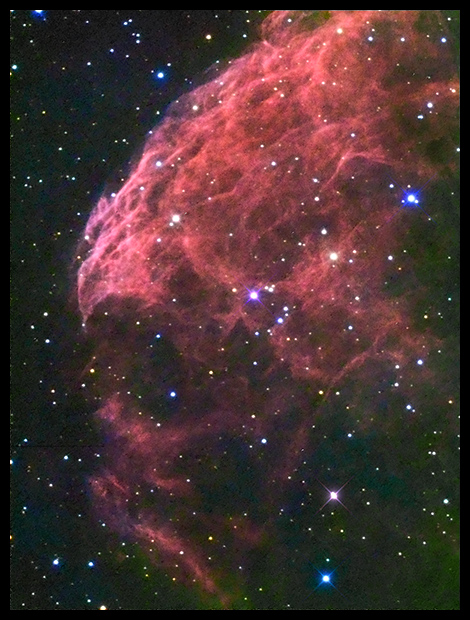12/19/2011. It's beginning to look a lot like Christmas. Expose long enough and mix the light just so, and the blue supergiants and brilliant red H-II regions of a neighboring galaxy begin to look more than a little festive.

M33
16x900s L + 3x900s L, 2x1800s H-a, 1x900s RGB
Fresh darks added to the mix, sub-arcsecond tracking, decent polar alignment and about six hours total exposure. That's a pretty good start.
I was standing in the shower last night thinking about the distance modulus to M33 (oh, yes I was) which is about 25 magnitudes. I'm confident that I'm getting into the 19's, so I should be capturing individual stars in M33 that are brighter than about -5 or -6 absolute magnitude. How many stars might I be able to photograph in that galaxy? (M33 is face on, so there's practically no loss due to absorption in its dust clouds, so ignore that consideration.) At a guess, I'm thinking more than 10,000 and less than one million, maybe something in the hundred thousand range, but that's predicated on some pretty rickety assumptions about the distribution of stars by luminosity and a single source for the total stellar population of M33 (40 billion). Approximations notwithstanding, some clear and steady nights should produce some serious glitter.
Turns out that the so-called luminosity function of stellar populations is a more subtle thing than I had imagined; a none-too-careful search for references turns up nothing but caveats about local regions of particular galaxies and nothing at all about galaxies as a whole. I'm thinking my simplifying assumptions were skewed way high by intuitions and rules of thumb based on distributions by apparent magnitude. So: a few thousand to tens of thousands perhaps?
12/24/2011. A collimating ring from Teleskop-Services joins the team to allow me to adjust camera tilt independently of the rest of the telesope's collimation. It takes up about 15mm of backfocus, so I removed the last extension ring from between the rear cell and the focuser and used this instead. We'll get all techie about it soon.

For now, let's leave it at this: it works great. There are three small set screws that determine the angle of the "film plane" and three large bolts that hold everything in place. Loosen a big bolt, turn the small set screw, tighten down the big bolt and you've adjusted the angle. I took out all the adjustment, measured a 30s starfield around NGC 7331; selected the easiest to reach bolt and put in about 1 turn of the set screw and cinched it down again. Re-measured. Half the tilt was gone. I did it again, and all the tilt was gone. I mean all of it: 0.0 degrees in two axes. That's pure luck. There may be accidents of measurement at work, but one of the test frames has stars under 1.9 arcseconds wall to wall. Throughout the night, I saw tilts up to 0.2 degrees reappear. Maybe there's that much slop somewhere in my imaging train. Anyway: this works every bit as well as hoped for; full technical exposition to come after another night or two of experience. The nicest thought at the moment is that I can now adjust both mirrors as fanatically as I like and be confident that the sensor can be re-adjusted to coincide with the focal plane. And the second nicest thought, vying for nicest, is that far off-axis star images are significantly tighter: that improves guiding with the OAG (PHD reports RMS 0.3" - 0.4" from evening into early morning when I left it to run on its own). Or else the seeing was far better than usual, which I don't believe was the case.
I shot M33 first. The full frame is measurably and noticeably sharper than the one at the top of this page, but I doubt the difference will be apparent on the web:

M33
10x900s L
3x900s L, 2x1800s H-a, 1x900s RGB
And then I got started with IC 443:

IC 443, a supernova remnant in Gemini
9x900s Ha used as L
1x900s RGB
Clouds too thick for imaging moved in about halfway through the planned H-a series, but there's still enough data to pile up into a good start. From previous efforts with the 5-inch refractor, I don't think there is a practical limit to how much exposure this subject can use. It's worth noting that the nebulosity in this image is jammed way over to the left side of the histogram; it occupies only 400 levels out of 64,000. Get some L-data and more RGB; there's a subtle blue haze just ahead of the red shock fronts that's just dimly seen here. I cut my favored H-a exposure in half to 900s because I think the polar alignment has slipped after three days of rain and I didn't want to mess up a sharp image with excessive field rotation. Slews were landing well wide of perfect, which is the first sign that things are not lined up quite as well as I'd like. Next time: get the polar alignment back and doublecheck that the sensor and focal planes are coincident. And remember to use the dew shield. And turn on the computer's heating pad.
Except where noted, deep-sky photos are made with an SBIG ST2000XM CCD behind a 10-inch Astro-Tech Ritchey-Chretien carried on an Astro-Physics Mach1GTO. The CCD is equipped with Baader LRGB and 7nm H-a filters. A Meade DSI Pro monochrome camera looking through a modified Orion off-axis guider keeps the OTA pointed in the right direction. The imaging camera is controlled via Nebulosity 2; the guide camera is operated by PHD Guide 1.13, both by Stark Labs. The stock focuser on the AT10RC has been augmented with Robofocus 3.0.9 using adapters turned on the lathe downstairs. Maxim DL5.12 performs image calibration, alignment, and stacking; Photoshop CS4 and FocusMagic 3.0.2 take it from there. Gradient Xterminator by Russell Croman and Astronomy Tools by Noel Carboni see their share of work, too.
:: top ::